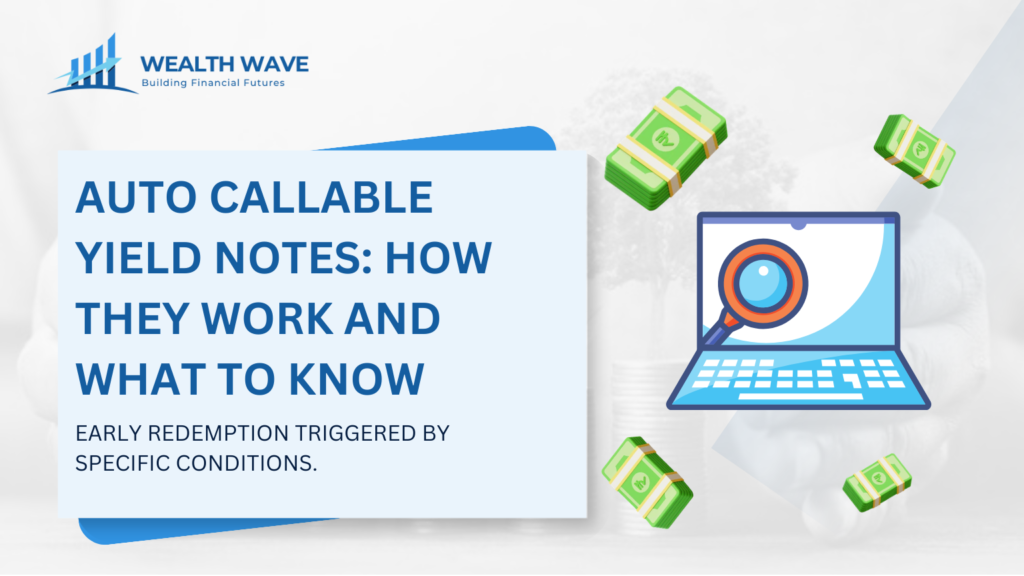
Are you on the lookout for ways to get your money to work a little harder for you? It’s something many of us are after, particularly during those times when traditional fixed income bonds just don’t seem to do the trick.
You’re not alone in this; it’s a common quest, and yep, we’ve walked that path too. That’s precisely why we dove headfirst into exploring auto callable yield notes (ACYNs), a creative investment avenue that might just add some zest to your portfolio.
While delving into our research, we stumbled upon an interesting tidbit: most auto callable yield notes often find themselves being redeemed by issuers way before they hit their maturity date.
This characteristic intrigued us and propelled us further into discovering how these financial instruments could potentially offer enhanced yields in comparison with traditional bond investments of similar credit ratings and maturities.
In our blog post, we’ll guide you through what ACYNs are all about, their workings, alongside their potential upsides and downsides. Ready to level up your investing game? Stay tuned!
Key Takeaways
- Auto callable notes combine structured product features with contingent income, offering the chance for enhanced yields over traditional fixed income bonds.
- These notes often come with an automatic call feature allowing issuers to redeem them early. This means most auto-callable notes do not reach maturity but are instead redeemed within a few years.
- The return on these investments heavily depends on the performance of reference assets, such as stocks or indices. A poor performing reference asset could lead to no coupon payments.
- While offering potentially higher returns and principal protection, auto callable yield notes carry risks including credit risk from the issuer and market performance impacting income.
- Investors receive monthly interest payments until an early call is initiated by the issuer under specific conditions, which can impact expected long-term gains.
What are Auto Callable Yield Notes?

Auto callable yield notes represent a unique investment option. They combine elements of structured products with features like contingent income, offering investors enhanced yield potential.
Definition

Auto-callable yield notes, or ACYNs, offer us a unique investment option. They serve as structured products that provide enhanced yield compared to fixed income bonds with similar credit ratings and maturities.
These notes carry an automatic call feature, allowing issuers to redeem them early if specific conditions are met.
Investors like us receive monthly interest payments while holding these notes. The appeal lies in their potential for higher returns. However, we should remain aware of the risks involved, including the possibility of not receiving any coupon if the reference asset performs poorly.
Structure

Auto-callable yield notes (ACYNs) feature a specific structure that enhances their appeal for investors. These financial instruments typically include an automatic call feature, allowing the issuer to redeem them early under certain conditions.
This unique structure often leads to most auto-callable notes being redeemed within just a couple of years after issuance.
The underlying reference assets can vary widely, but they commonly include equity indexes like the Dow Jones Industrial Average. Investors receive monthly interest payments as long as the performance criteria are met.
While these notes provide higher yields than fixed income bonds with similar credit ratings and maturities, they also carry risks tied to the issuer’s creditworthiness and market performance.
Reference Assets

Reference assets play a key role in auto callable yield notes. These financial instruments often reference stocks, indices, or other securities to determine their performance and payouts.
The return we receive from the notes depends on how these reference assets perform in the market. If they perform well, we enjoy higher yields and consistent monthly interest payments.
We recognize that many auto-callable yield notes offer enhanced returns compared to fixed income bonds with similar credit ratings and maturity. However, if the underlying asset does poorly, we risk not receiving our coupon payments.
Thus, understanding these reference assets is crucial as they directly impact our potential investment loss and overall experience with these notes. Next, we’ll explore how auto callable yield notes work more closely.
Risk Analysis
Auto-callable yield notes carry several risks that we need to analyze carefully. The potential for an early call can catch us off guard. Most auto-callable notes do not reach maturity; they often redeem within a couple of years.
This short duration may limit our expected returns.
The performance of the reference assets significantly impacts our income from these notes. If the underlying stock performs poorly, we might not receive any coupon payments. We should also consider the credit risk associated with the issuer since it can affect our investment’s stability and safety.
Ongoing investigations into brokerage firms selling auto-callable notes highlight these concerns even further. Understanding these factors helps us make informed decisions in today’s bond market.
How do Auto Callable Yield Notes Work?

Auto callable yield notes offer principal protection while providing enhanced yield potential. They typically pay a contingent income based on the performance of reference assets. If these assets meet certain conditions, the note may call early, returning our initial investment along with any accrued interest.
This structure helps us manage risks and maximize returns in fluctuating markets. We should explore how this unique financial instrument can fit into our investment strategy for better outcomes.
Principal Protection
Principal protection plays a key role in auto callable yield notes. These notes often allow us to protect our initial investment while still seeking higher returns. Monthly interest payments provide contingent income, enhancing our overall yield compared to traditional fixed income bonds.
However, we must remain aware that most auto-callable notes do not reach maturity and may be redeemed early.
The potential for early call exists under certain conditions set by the issuer. If the reference asset performs well, we may receive automatic payments sooner than expected. This structure offers us a unique blend of principal protection and enhanced yield but carries risks as well.
The credit risk of the issuer also factors into our analysis before investing in these products.
Enhanced Yield
Auto callable yield notes offer an enhanced yield that surpasses the returns of fixed income bonds with similar credit ratings and maturities. Investors benefit from higher interest rates compared to typical debt securities.
With these notes, we enjoy monthly interest payments, providing a steady stream of income.
Most auto-callable notes do not reach maturity. Instead, they usually get redeemed within a few years of issue. While these investments promise attractive yields, we must be cautious about performance risks related to the reference assets involved.
Maturity and Payment
Maturity and payment are vital components of auto callable yield notes. These notes offer monthly interest payments to investors, which provide a reliable stream of income. Most of us understand that these instruments usually do not reach maturity.
Instead, they often get redeemed within a few years after issuance.
We see that the automatic call feature allows issuers to redeem them early under specific conditions. This means we might not hold onto our investment until it matures. While auto callable yield notes deliver enhanced yields compared to fixed income bonds with similar ratings, we must also consider the risk involved if the underlying reference asset does not perform well.
Potential Benefits of Auto Callable Yield Notes

Auto callable yield notes offer investors a chance for higher returns compared to traditional fixed income bonds. These notes also present lower interest rate risks, making them an attractive option for those seeking enhanced yields without taking on excessive exposure.
Higher Yield than Fixed Income Bonds
Auto callable yield notes offer a higher yield than fixed income bonds. They provide an enhanced yield, which often exceeds that of comparable bonds. For instance, the coupon on auto-callable notes is generally greater than that of a fixed income bond with the same credit rating and maturity.
Most auto-callable notes promise better returns because they typically offer higher interest rates than what we find in today’s debt securities.
These notes can significantly boost our investment income while maintaining principal protection. Unlike traditional bonds, which might lock us into lower yields for years, auto callable yield notes usually redeem early within just a couple of years after issue.
We receive monthly interest payments too, making this option attractive for generating consistent cash flow during retirement years.
Lower Interest Rate Risk
Auto callable yield notes offer us lower interest rate risk compared to traditional bonds. These notes typically provide a higher interest rate than the yield available on debt securities of comparable maturity.
By choosing auto-callable yield notes, we can benefit from enhanced yields while shielding ourselves from fluctuations in interest rates.
Most auto-callable notes redeem within a couple of years rather than reaching full maturity. This feature reduces our exposure to long-term interest rate changes. We receive monthly interest payments as long as the reference asset performs well, mitigating potential losses due to rising rates that often impact fixed-income bonds.
Credit Risk Mitigation
Credit risk mitigation plays a vital role in auto callable yield notes. These notes offer higher yields, but they also carry inherent risks. By investing in auto callable yield notes, we can reduce our exposure to credit risk associated with traditional investments.
Monthly interest payments provide income while allowing us to avoid some of the pitfalls tied to bond pricing and bond valuation.
The structured nature of these instruments helps us navigate potential defaults by issuers. An understanding of the issuer’s creditworthiness can guide our investment choices effectively.
As we explore how these notes work further, we’ll learn about their principal protection and enhanced yield features.
Considerations and Risks of Auto Callable Yield Notes

Auto callable yield notes come with some risks that we must evaluate closely. The chance of early call can limit our returns, while the performance of reference assets may significantly impact our income.
Potential for Early Call
Auto-callable yield notes come with an automatic call feature. This allows the issuer to redeem the notes early under certain conditions. Most of these notes do not reach maturity and get redeemed within a couple of years after issuance.
We receive monthly interest payments until an early call occurs. If we hold these notes, we may miss out on longer-term gains if they are called too soon.
The potential for an early call can impact our investment strategy. It offers us enhanced yield but carries risks as well. The stock’s performance influences whether the note gets called before maturity.
Poor performance might result in us not receiving any coupon at all, while good performance leads to higher returns through auto-callable options. As investors, we must weigh these factors carefully when considering callable bonds or contingent income notes like ACYNs.
Impact of Reference Asset Performance
The performance of a reference asset significantly impacts auto callable yield notes. If the underlying asset performs poorly, we face the risk of not receiving any coupon payments.
This situation can happen even though these notes provide an enhanced yield compared to fixed income bonds with similar credit ratings and maturity dates. The automatic call feature ties our returns directly to how well the reference assets perform in the market.
We must closely monitor these assets. Their performance decides whether we receive monthly interest payments or if our investment gets called early. Our strategy for yield enhancement hinges on understanding potential market movements and their effects on auto-callable yield notes.
Investing in these products carries risks, including fluctuations in asset prices that could reduce our overall returns or lead to losses if conditions aren’t favorable.
Credit Risk of Issuer
Credit risk of the issuer poses a significant concern for us as investors in auto callable yield notes. These notes depend on the financial stability of their issuers. If an issuer faces difficulties, it may struggle to make interest payments or even return our principal at maturity.
Several brokerage firms currently face investigations regarding the sales of these notes, which highlights potential risks associated with investing in them.
We know that auto-callable yield notes can offer higher yields than traditional fixed-income bonds. Yet, we must also consider credit risks linked to the issuers behind these investments.
If we find ourselves holding such notes during downtimes for the issuer, we might not receive any coupon payments if stock performance falters. Understanding this risk is crucial for safeguarding our investment strategies and ensuring better decision-making around auto callable options.
Conclusion

Auto callable yield notes offer unique benefits for investors. They provide higher yields compared to typical fixed-income bonds. Our investment strategy can lead us to enhanced returns while protecting our principal.
We must, however, consider the risks involved, such as early calls and reference asset performance. Think about how these notes could fit into our portfolios. With proper understanding, we can make informed choices that may boost our financial goals significantly.
FAQs
Q1. What are auto callable yield notes?
Ans. Auto callable yield notes are financial instruments with an autocallable option. They offer a return linked to the performance of a specific market index.
Q2. How does the yield curve affect auto callable yield notes?
Ans. The shape of the yield curve can impact these notes' value. If interest rates rise, it may lead to an increase in their prices and vice versa.
Q3. What is risk analysis in terms of auto callable yield notes?
Ans. Risk analysis involves assessing the potential losses from these notes due to changes in market conditions like shifts in the option-adjusted spread or variations in yields to maturity.
Q4. How does an autocallable option work within these notes?
Ans. An autocallable option allows issuers to call back or redeem their issued notes before they mature if certain predefined conditions are met.




